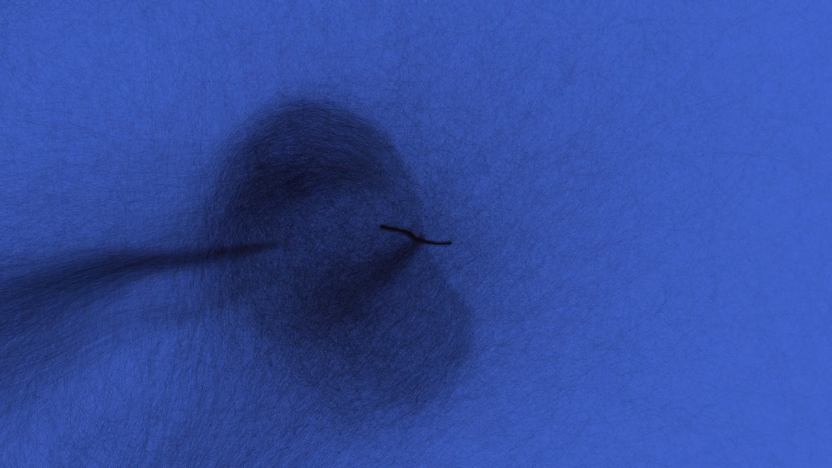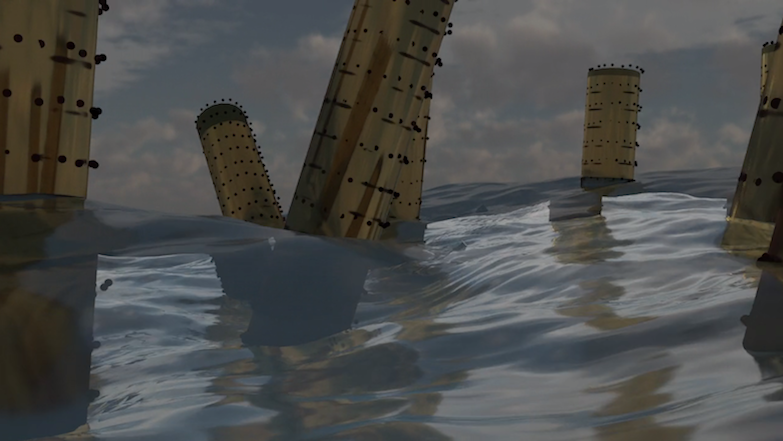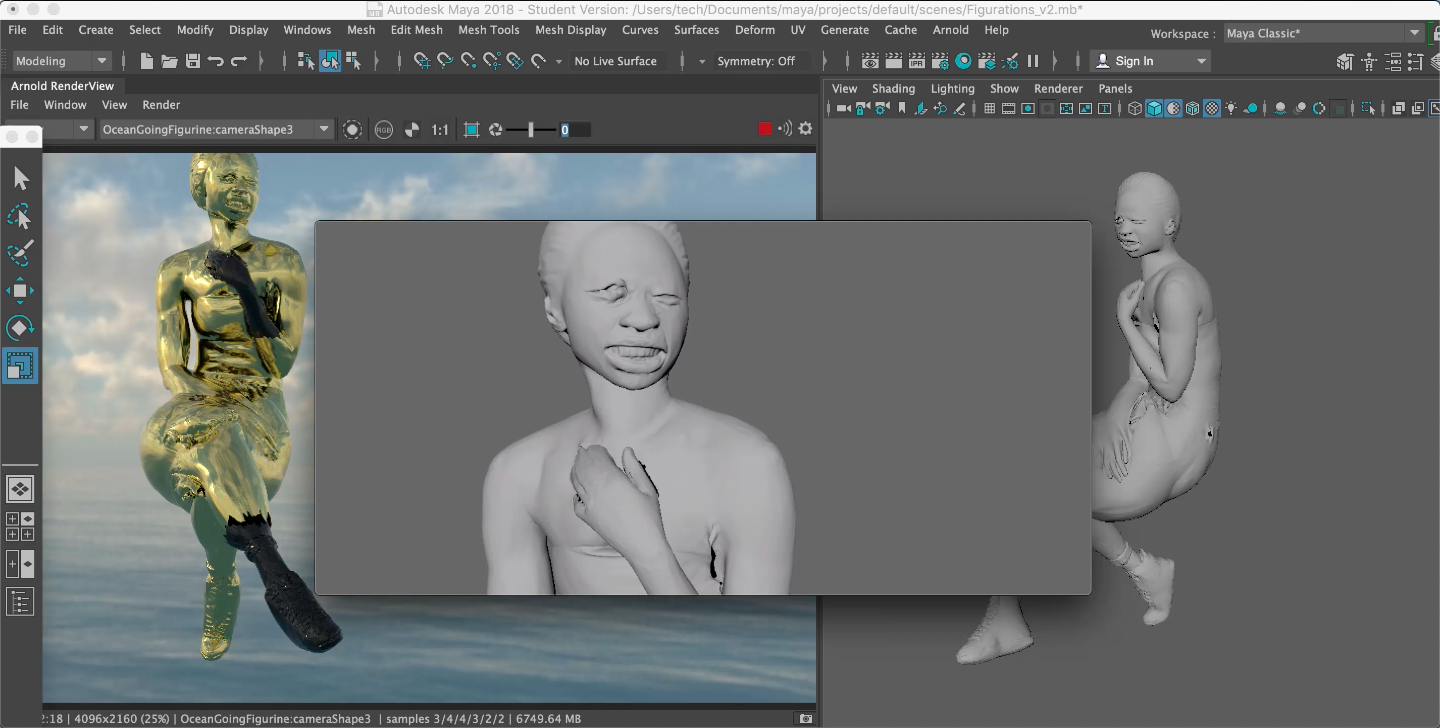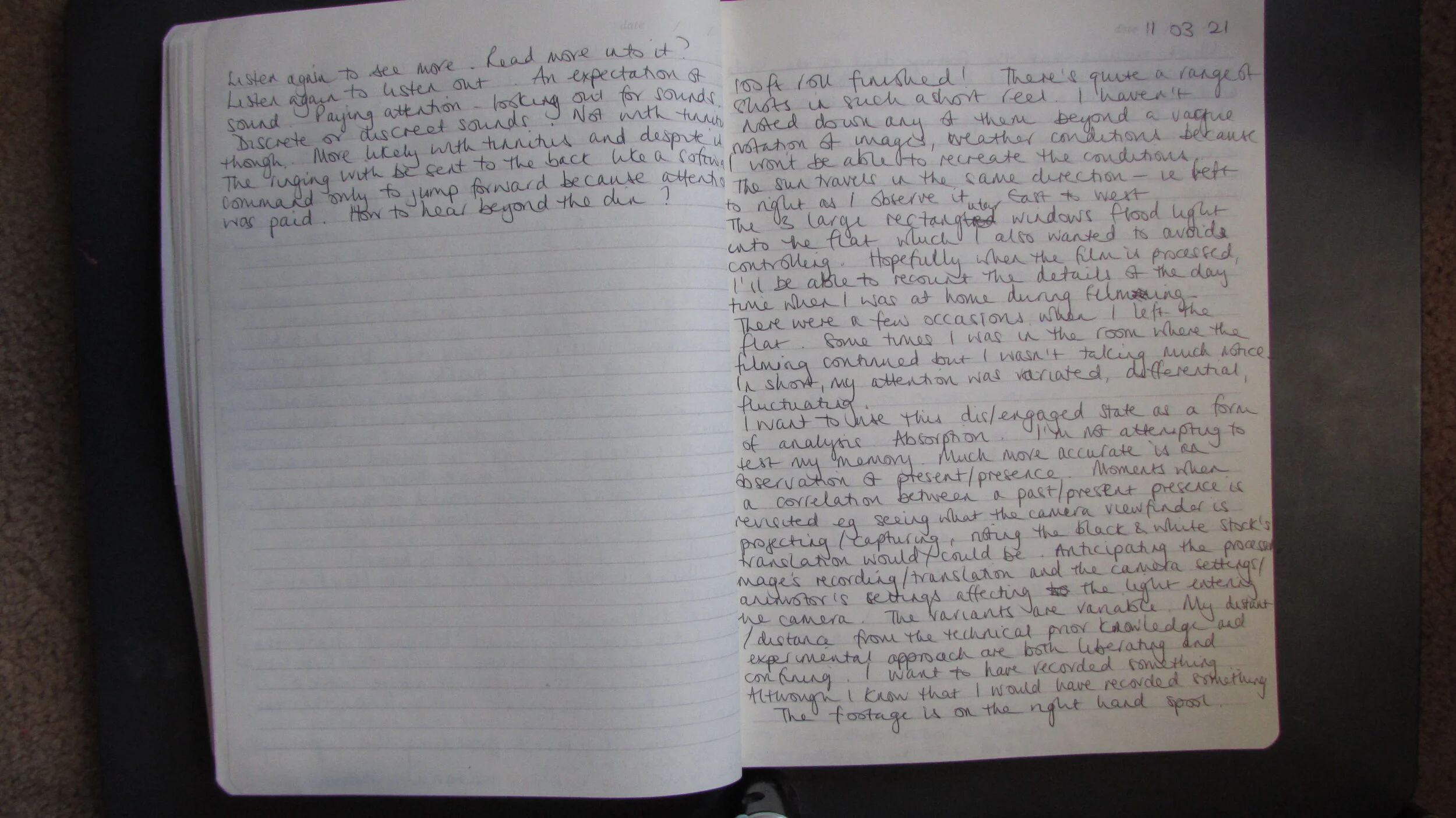When We Worked At Raleigh: Contemporary Art Commission
Maybelle Peters
Courtesy of Maybelle Peters
Building on When We Worked At Raleigh, we are pleased to announce that artist Maybelle Peters has been commissioned for a period of research and development, working towards the creation of a new moving image artwork in response to the archive.
The commission explores how contemporary art practice can respond to an archive, to draw connections between the past and the current moment. Maybelle will approach the archive by considering what it means to pay attention, beginning her research with a process of close listening to the rich audio material. Working with and in between archival materials and animation’s boundless medium offers a way to produce relational modes of film-making. During the R&D phase, Maybelle will explore how Black bodies move, and are moved - aiming to generate notions of Black social life through movement that is specific to a place. She is interested in drawing out movement that isn’t necessarily seen but heard in the voices and that come to life during reading, looking and listening.
This project has personal resonance to the specific narratives of migrants and the diaspora from The Commonwealth Caribbean. Maybelle's parents' history of leaving a newly independent Guyana in the 1960s to work and build a life in England converges with the stories documented in the Raleigh archive.



Maybelle Peters is a London based artist and filmmaker working in film and CGI. Her practice focuses on storytelling using documentary, historical events, literature and oral narratives. She gained her bachelor’s degree in Animation at Farnham where she made her first commissioned film for BBC2. Her Channel 4 commissioned film, Mama Lou, has been shown extensively at animation festivals including Annecy, Ottawa and the Edinburgh Film Festival as well as broadcast television. She is the recipient of the inaugural Womxn of Colour art award. Her work was shown as part of The Place is Here exhibition at Nottingham Contemporary and South London Gallery in 2017. Maybelle is a practice-based PhD candidate at UCA Farnham and her practice explores allegorical tales and myth making and more recently looks at gleaning stories from objects, personal rituals and an archive of ephemera, gestures and sounds.
When We Worked at Raleigh is a partnership project by Nottingham Black Archive and Primary documenting the experiences of members of the Windrush generation, and their descendants, who worked for Raleigh Industries from the 1950s to the 1980s. Over the course of the project, Nottingham Black Archive collected oral histories, documenting arrival and day-to-day experiences, and contributions to challenging racism and increasing workplace equality in one of Nottingham’s most famous industries.
This project is funded by the Windrush Day Grant Scheme, adds to Nottingham Black Archive’s growing collection and is part of the Making Place programme at Primary.
Attention: Absorption
An unfolding programme of research by Maybelle Peters
Following the factory clock, Nottingham Black Archive and Primary are releasing Maybelle Peters' research at the beginning and end of the office workday. Each set of research will be shared here every four days between Tuesday 22 June - Thursday 15 July, with the programme launching on Windrush Day.
Tue 22 Jun, 9:00am
Category: Archival
Archive notes 1
Became @ Raleigh 70s
YTS Just the labour — work less a year.
relational friendships between spaces in work , leisure, ‘social differences’
clean work vs dirty work. Raleigh smell
See it, feel it — you know it
experience from other people – re-employment bans. other companies
explore the nature of power relations
The actions — performative non-bias
distancing
‘Lose where they’re coming from’
coercive, promotion (responsibility) balancing act.
‘see the changes’
Iona
early morning – to work – to home
family. sister. mum, dad.
Large group of black people.
dealt with it in your own way. don’t vocalise them.
A lot of good friends — close friends
not a bike rider
Archive notes 2
Listening to the When We Worked At Raleigh podcasts — the 3 I listened to previously
'the gap between the expectations'
‘the gaps.’
The terms and conditions
What is required
Bettina Wallace ‘was wind back in the day’
specialist compound for tyres (formula) for African & Asian markets.
inner tubes
The paradoxical family tree of Bettina Wint – Jamaican
Raleigh manager Mr. Wint, English
Camaraderie. Raleigh, Players, Bush industries
Black families – workers. black apprentices.
Social club – events at Raleigh
Looking for map – lights like an aerial view of a flight path
Podcast 2 BG 1930 Jamaica Burnette
England 1953
Management Supervisory.
consider the socio-political aspect where BG as a non-union member, helps the management through a problematic political issue that affects productivity. He is given access to training only when his suggestions is advantageous. His access to training and subsequent promotion is not viewed favourably by the young black men. His separation is seen as problematic — out of place? A sellout?
No one of them?
Raleigh pays for the course.
Facing down racism, e.g. in a position of power.
Tue 22 Jun, 5:00pm
Category: Archival
Archive
25/03/2021
A short sequence using the tree film + stills with colour sequence as well as the original 4K sequence will be assembled for research presentation.
I’m focusing on Bettina mainly because there’s quite a lot I’d like to unpack. Here recollection/s are forming a narrative even though I’m not set on creating a story. What’s more interesting is how I can articulate the range of stories she tells. Office politics, forming friendships – lifelong ones including Kinship. She moves through spaces – physically from shop floor to office spaces psychologically with being ‘placed’ and ‘misplaced’ – e.g. name. It’s a refusal to be placed. A response to being subjected. Her surname through marriage connecting her to a manager revealing bonds that are open for paying attention to. A closer look. ‘My Mr Wint is black’.
The running joke – i.e. continual ‘placement’ of separation when there’s a connection. That’s a moving away, a distancing that is historical, a part that remains fixed and present and future. Present and absent Bettina absorbs these microaggressions. She refuses to take that on but at times does take them on. Her insistence on dressing for work despite an attempt (or attempts) to implicate her actions as inappropriate – dress, teapot, cleaning. She makes her space and holds it.
Listen again to Bettina’s shop floor walk.
26/03/2021
The material selected
27/03/2021
Another battle with technology. What should have been a fairly straightforward set up to shoot timelapse with the software on a laptop with a camera ended in defeat. The software just is subject to compatibility with hardware. For too many hours was spent trying to get something to work on 2 different machines. Plan B is to shoot live-action and extract frames to simulate timelapse. I’ll use both a stills camera capsule or taking video and a digital video that records onto tape. The other option is to buy a battery for my old titanium laptop that has been used for animation and hand’t been updated. There it’s a tried and tested piece of kit. A replacement battery should be possible if purchased online. Failing that, a second-hand titanium MacBook pro is under £200 but the OS will be a problem. Oh! t e c h n o l o g y is a bind! There is always another way ‘round. I could even use the digital screen capture from google maps if need be. I’d much rather try to take the images in situ.
Archive as Response
From the box of slides, a set of images are piled up with themes that bring me back to the audio recordings. Some of these are deliberate i.e. industrial, sovereign, ideas of Britain present in the composition, representation, symbolic. Others related to the effects of wind on the landscape.
Each slide connects in one way or another to the 3 voices as a general, an overview of hearing and responding to voices talking about their experiences of working in a British industrial environment.
Among the slides are 3 photographs of black people. There are over 150 slides in the box. The rarity of finding images of black people photographed in and amongst a non-curated selection of images is unsurprising to me. I don’t recall ever finding a large or even more than a handful of images.
My reason for starting this is because I’m considering whether there’s always a conscious effort to attend to the numbers of black people. To monitor, look out for, survey, keep track of and control. The presence is noticeable but is it actionable?
I can’t say with any certainty whether I acted out these slides containing images of black people and added them to the box I bought from the car boot. It’s inconclusive and not offering any insight into what I pay attention to. However, I have decided to pick a small selection that is of interest as a response.
The 2nd response I looked at earlier in the research was the audio recordings made on a trip to Blackpool in August 2017. I’ll decide during the week once I’ve sent the films off for processing if I want to include them.
My thoughts on using them were because I was attempting to do the same type of documentation of elders’ stories but as an absent-present witness, i.e. use the audio recorder as my ears. To sit still and hear the presence of people I would normally listen to in a different way. That way would be listening to respond. Therefore, I made myself absent.
But I was travelling with my mother, and even though I wasn’t sitting next to her, I didn’t remain absent for long. I did manage to hear their voices along with the audio recordings hearing. I might play the recordings as an example of paying attention as it is an example of a previous exercise in what I’m trying to do in this research. Paying by doing something that facilitates attention.
Stillness seems to be something to explore further and distancing — out of focus or maybe not a fixed focus.
A de-privileging of focal points.
I wonder if I have managed to do that on film.
Fri 25 Jun, 9:00am
Category: Playful
Audio Noted - TASCAM_0033, 0044, 0045, 0046, 0047
Humming - humming.aif
Not at work today - TASCAM_0075
Audio Noted, Humming, Not at work today
These audio recordings are a series of archival files made before the commission. In thinking about responses to the Raleigh commission, I decided to think about what came to mind when writing the proposal. It was made when I wasn’t at work (in my previous day job), and they became recordings that were a way of registering the moments of actively being not ‘at work’.
Fri 25 Jun, 5:00pm
Category: Artistic
Worker_1 and Worker_2
Not being at work and remembering what it’s like to be at work. There’s most of the detail there but it gets mixed up with the additional things such as the shapes, machine parts and bodies that were in the same spaces. The monotony and the mundanity. The fixed points during the day became a reminder that something else is governing how to move and where to go.
Raleigh_excerpt_TestREnder2
A glitch. One of a series of glitch videos. What should have been a screen recording of fairly muted colours (greys and greens) from the software turned into a fleet of pinging colours. In Legacy Russell’s Glitch Feminism, the refusal of no is offered. ‘To glitch is to embrace malfunction, and to embrace malfunction is in and of itself an expression that starts with “no.” I didn’t even try to re-export as the refusal in ’nope’ opened into an offering.
Russell, Legacy. Glitch Feminism (p. 22). Verso. Kindle Edition.
Tue 29 Jun, 9:00am
Categories: Artistic, Playful and Technical
Garlands
Playful, ‘Garlands 1’
Playful, ‘Garlands, 2’
Instead of taking photos of the garlands, I opt for filming them at a slower frame rate. 64 fps. I hadn’t wanted to shoot any colour film but testing out the camera that hadn’t been used for over a decade seemed a sensible decision. Neither had I shot anything on such a slow frame rate. The timelapse machine had stopped working by the time I came to film the garlands. The manual shoot blurred and distorted the image which despite not being useful as film, has been applied as a still image background for the computer generated image (CGI) element of the work.
Contingent_Bodies_film
The black and white 16mm film transfer to digital video was a complete surprise. The amount of guesswork shifted between fairly educated decisions to blind faith. What was especially difficult was estimating how much light was available during the night when the street lights and passing car headlights synchronised with the time-lapse shot. Streaks of light appear, indicating that there was enough light, but the shutter speed needed adjusting.
Using the master’s tools - modes of production
In this time-lapse recording, changes in conditions such as light are focused on to highlight the animateness of processes. In my film, the registration of conditional changes is emphasised due to the displacement of objects spatially and visibly. The legibility is predicated on constant changes in the following:
• the amount of light entering the camera
• the camera’s vulnerability to vibrations from the surface
• the recorded image’s shutter speed exposing light to the film
• the movement of the tree branches
A photosensitive material that reacts to the amount of light entering the camera when loading the film appears as a description for meteorological phenomena. ‘Fogging’ reduces the visibility of the recorded image but is also affected by the amount of daylight entering the lens as the shutter opens.
In an ongoing cycle of adjustment, there is a vigilant intervention occurring. At times this is in anticipation of unfolding weather patterns that are both speculative and intuitive.
Each method of recording using the Bolex camera has an accompanying soundtrack.
Tue 29 Jun, 5:00pm
Category: Technical
Each method of recording using the Bolex camera has an accompanying soundtrack.
Manual film record
The single-frame recording never achieves a steady, regular rhythm. A monotonous, repetitive task is always interrupted by some more or less interesting distractions. In trying to mimic an automaton, I end up recording continuous attempts to keep time.
Time-lapse recordings
Each sound sequence provides a recording pattern that indicates how much light the film is exposed to. They all help establish an aural indicator I can use when I’m in the room keeping an eye on the weather. The green light appearing for the same length of time as the open shutter become collaborators in keeping the tree branches visible.
Sat 3 Jul, 11:00am
Category: Theoretical
Hartmut Rosa
You have suggested that ‘resonance’ with the world around us is key to a better life. Could you explain the idea – and whether or not the last year may have helped more of us achieve it?
Resonance is a certain way of relating to the world, of establishing contact with people, with things or with nature. It has four elements.
The first is something that really speaks to us or touches us.
The second is the capacity to reach out and do something – answer the touch or the call and experience oneself as being alive and capable of having an impact.
Number three is that we don’t stay the same, that we somehow experience a transformation within our whole being and our way of relating to the world.
The fourth element is that you cannot enforce or manufacture resonance – you cannot decide that tonight I will be deeply touched by my girlfriend or by music or a book.
The pandemic took away a lot of the things that we resonate with – going to a concert or the movies or travelling to the mountains or the ocean – but it has also given us the time to rediscover our areas of resonance. However, one thing I found interesting is that a lot of people discovered that what they thought they would really want to do if only they had enough time didn’t deliver its promise. They found Proust was boring or didn’t enjoy learning the piano. It has freed us from a lot of illusions.
Further Reading: Resonance. A Sociology of our Relationship to the World (2019)
Sat 3 Jul, 6:00pm
Categories: Theoretical and Playful
A brain circuit that suppresses distracting sensory information holds important clues about attention and other cognitive processes.
Wed 7 Jul, 9:00am
Category: Playful
Playful Journal 1
Playful Journal 2
Wed 7 Jul, 5:00pm
Category: Playful
Playful Journal 3
Playful Journal 4
Sun 11 Jul, 9:00am
Category: Artistic
Screenshot 2021-04-18 at 21.24.09
The CGI figure used has become a proxy for a number of works recently. Not only has its story of a chance find been significant in the R&D phase but the decision to keep using this figure because no alternative solutions were satisfactory. Another chance find of encountering a way to absorb the environmental colour in real-time, made the find all the more rewarding.
Screenshot 2021-04-19 at 16.21.22
Composite screenshot of animation and colour tests. The selected colours reserved for Bettina are purely speculative. I have no idea what her favourite colour is but decided that the initial choice of pink worked. Thinking ahead and as an installation, I’d want a very distinctive colour to appear elsewhere in the space. This would be a reflection or projection. The pink would be present in, between and in front various place.
Screenshot 2021-04-19 at 16.27.11
An amalgamation of moving image pieces that form the main area of R&D. The sometimes imperceptible movement of the main figure. The exaggerated form and animation of the seated figure as well as the fluctuating visibility and animation of the trees are the culmination of paying attention to the black Raleigh workers whose voices are a permanent presence in the archive. Finding a way to attend to those voices without illustrating them, was the main aim.
Thu 15 Jul, 9:00am
Categories: Artistic and Theoretical
Absorbtion
Following on from the tests with materials that worked with lighting, the real-time effects prototype had to be adjusted a few times. Still, eventually, something resembling an idea of absorption started to work. It is still a matter of continuing to tweak settings, but focusing on colour in the R&D phase will be changed when the footage shot outside, and inside the Raleigh building is used.
Thu 15 Jul, 5:00pm
Categories: Artistic and Playful















